ORCAS





Orcinus orca, commonly known as the “orca” or “killer whale”, is the largest dolphin in the cetacean family. They are the most widespread cetacean, present in every ocean across the world, and represented in varied habitats. There are several ‘subtypes’ of orca, which some scientists suggest may be separate species or subspecies. Certain populations or subtypes are considered threatened or endangered due to varying factors, such as food scarcity, human threat, and pollution; the Southern Resident population are classified as Endangered under the ESA, and the AT1 Transient Stock is classified as depleted under the MMPA. All orca populations are protected under the MMPA, although the Southern Resident is the only endangered population. There are an estimated 50,000 orca worldwide.
Taxonomically, orca are a part of Delphinidae – while Delphinidae as a group diverged from the rest of Odotoceti approximately 12-15mya, Orcinus are thought to have diverged shortly after. Phylogenetic placement of the species is under some debate, but the most recent studies suggest that Orcinus is one of the most basal Delphinidae species. There are two recognised extinct genera in Orcinus: O. citoniensis and O. paleorca. These species were both smaller than O. orca, suggesting that they slowly evolved to eat bigger and bigger prey.
Orca are the largest extant member of Delphinidae. While exact sizes can vary depending on ‘type’, on average males are 6-8 meters long and 6 tonnes, and females are 5-7 meters long and 3-4 tonnes. The largest recorded size for males is 9.8m and 10t, and for females is 8.5m. Calves are around 2.4m at birth. Males have larger dorsal fins than females – while the dorsal of the female is generally gently curved and about 91cm tall, male dorsals are tall and straight, sometimes reaching 1.8m in height. Orca reach sexual maturity between 10 and 18 years of age, and females can continue breeding until their 40s. Orca are one of the few species besides humans that go through a menopause and live past their reproductive prime – this is theorised to be because orca engage in communal care, and elder females play an important role in teaching and supporting new mothers. Females live on average between 50-80 years in the wild, with the eldest (J2 Granny) being around 80. Males live between 29-60 years in the wild, and often die along with their mothers.
Orca are easily recognised by their stark black and white pigmentation; the back and flank are mostly black, with a white underbelly that extends across the entire lower jaw, and up the flank in lateral patches. Iconically, they also have a white ‘eye patch’ – an oval patch of white situated just above and behind both eyes. There is also generally a lighter grey patch behind the dorsal fin, called a ‘saddle patch’. Both the eye patches and saddle patches are important for identification, both of ‘types’, and of individuals. Newborn orca can often appear orange or yellow tinted over their white markings, but this fades as they grow. Some types of Antarctic orca may have yellow tinting to their white markings, and this is thought to be due to diatoms in the water where they live.

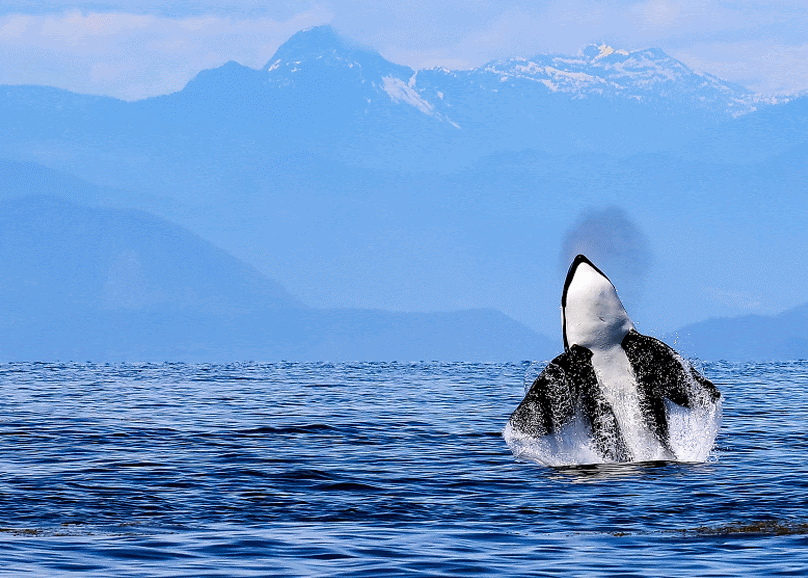
An orca breaching
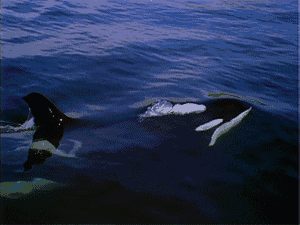
An orca surfacing for breath
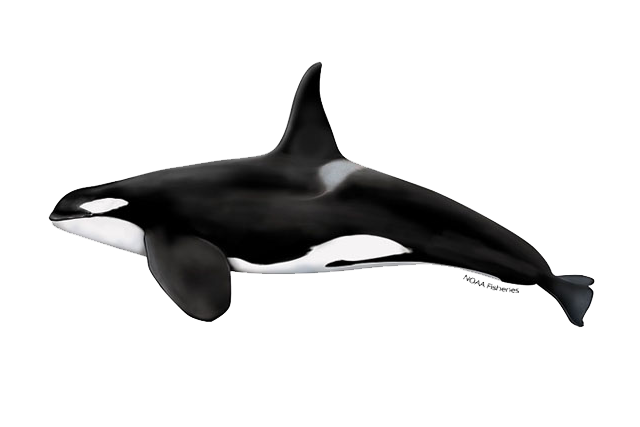
Orca markings
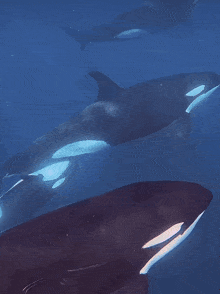
A pod of orca swimming underwater

A pod of orca rubbing against pebbles

There are three main ‘types’ of orca recognised in the North Hemisphere, mostly defined by their diet and lifestyle.
‘Resident’ orca stay in a regular territory, generally near coasts, and have a fish-based diet with occasional squid. The most famous Resident population are the Southern Residents (SRKW), which consists of the J, K and L pods, but there are also the Northern Resident (NRKW), Southern Alaskan Resident, and Western Alaska North Pacific Resident populations. Salmon is the preferred food source of the NRKW and SRKW, with the Southern Residents preferring specifically Chinook salmon; their depleted populations contribute to the problems facing the SRKW.
‘Transient’ orca travel over much wider ranges and are almost exclusively mammal hunters. These orca share some of the same ranges as the Resident populations in the North Atlantic, however the two groups do not interact and avoid each other. Transients can be distinguished from Residents by their solid grey saddle patches, and the more triangular dorsal fins of the females. Three “stocks” of Transients are recognised; the AT1 stock, GOA/AI/BS stock, and West Coast stock. AT1 is considered ‘depleted’ after being affected by the Exxon Valdez oil spill.
‘Offshore’ orca have lifestyles and appearances somewhat similar to Residents, with notable differences including their diet (consisting of mostly schooling fish, as well as sharks and potentially some mammals) and habitat (open water, as opposed to the Resident’s coastal ranges). They have not been observed and studied as much as Transients and Residents, but they are known to be genetically distinct. Offshore orca are generally smaller than Transients or Residents, and females have a much more rounded dorsal fin.
There are many other subtypes of orca, and their diversity is thought to be massive. As well as the Resident, Transient and Offshore populations, NOAA recognises a Hawaii stock and a Gulf of Mexico stock which seem to be generally unrelated to the others. North Atlantic Type 1 orca are generalists, observed in Norway, Scotland, and Iceland. North Atlantic Type 2 orca are open-ocean mammal hunters. In the Southern Hemisphere, there are several types of ‘Antarctic’ orca recognised: Type A, Type B1, Type B2, Type C, and Type D.


Orca are a highly intelligent and social species. They have complex social structures, with only elephants and higher primates such as chimps and gorillas having similar levels of complexity. They show strong maternal bonds, complex coordination and communication when hunting, seem to form ‘friendships’ – showing preferences in the individuals they spend time with within their social group – and even, it seems, display complex emotions like grief. Tahlequah is a female of the SRKW J pod, who has twice been observed carrying her deceased calves for days after their deaths.
Orca are often seen travelling in groups called ‘pods’. These pods are generally familial groups, surrounding a matriline – a female orca and her offspring. Males in particular are thought to never leave their mothers’ pod, straying briefly only for breeding opportunities. Within orca ‘societies’, females are generally more high-ranking despite physically being smaller, and studies suggest that females play a lot of the key social roles within pods, including discipline and teaching of juveniles. Communal care is common enough to be standard – females will hold fish in their mouths while their young chew pieces off; young females will babysit while older females hunt; and it is females, particularly the older and more experienced ones, who will pass on knowledge such as food sources, hunting strategies, and communication skills.
In Resident communities, there are four social levels: matrilines are highly stable, and almost never separate; pods may consist of 1 to 4 related matrilines, and although generally close, they may separate for weeks to months; clans are groups of pods with similar dialects and distant matrilineal connection; finally communities are groups of pods that regularly interact, but have no relation. Resident social structures are particularly stable, and due to the long lifespan of females, up to four generations can sometimes travel together. L pod is the largest pod of the SRKW community, with 34 orca all travelling and socialising together.
In Transients, pods are smaller, generally a female and a few of her offspring; on average, 3 to 7 whales travelling together regularly. However, Transients are still highly social – although in day-to-day life pods travel as small immediate-family units, they will often meet up and travel with other pods. Sometimes, these are related pods – aunts and cousins, grandmothers and grandchildren – and sometimes their matrilines are completely unrelated, and the meeting seems purely social. During these meetings, calves from the pods play together, while mothers socialise. Males still remain with their mothers for their whole lives, while females will split off as they begin to have calves of their own.
These social structures seem to correlate to diet – fish-eating populations are similar to Residents, while mammal-eaters are more like Transients. This is theorised to be due to the sharper senses of mammals, who would be more likely to notice their predators if more were travelling together. However, all orca are social, and often rely on group hunting for food. Orca have been shown to have culture-specific behaviours which can be passed across generations and between individuals, and can differ greatly between populations. It is thought that even dietary preferences – such as the diet of Chinook salmon of Southern Residents – are due to cultural traditions. Cultural fads have also been seen to come and go; in the 1980s, the West Coast orcas started to wear dead salmon across their heads. This trend faded, but seems to have become popular again in recent years. Other communities have communal ‘rubbing beaches’ that they return to, to rub off dead skin and parasites.
Another social dynamic that is different between communities is language. Orca seem to have unique languages and dialects that can vary greatly – this could mean that different populations do not understand each other. It is possible to identify what community is in an area, based on their unique base of calls; sometimes, it is even possible to identify down to the matriline, due to distinctive ‘dialects’. Lolita seemed to recognise calls from L-Pod, her natal pod, and still used those dialect sounds throughout her life. Studies even suggest that language transfer occurs ‘horizontally’ rather than solely 'vertically'. This makes it clear that orca have complex social lives. Language studies of orca, and other cognition and intelligence research, are revealing more and more new information on the rich inner lives of orca.


An orca spyhopping
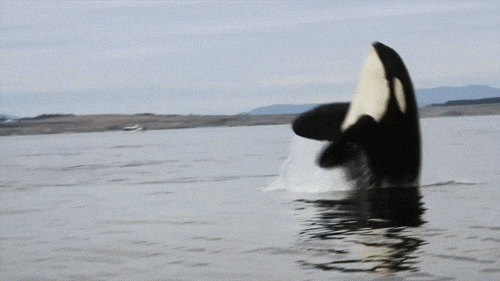
An orca backflopping after a breach
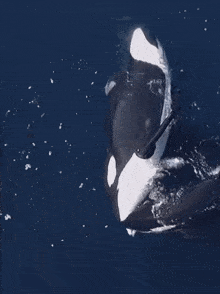
Two orca, possibly mother and calf, playing at the surface

An orca swimming at the surface
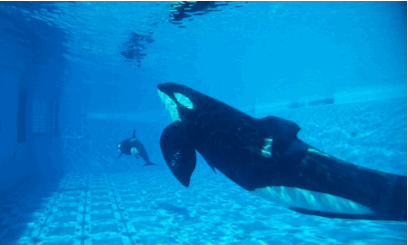
Captive orca in a display pool, exhibiting characteristic 'flopping' of dorsal fin

Captive orca Lolita/Tokitae in her tiny pool
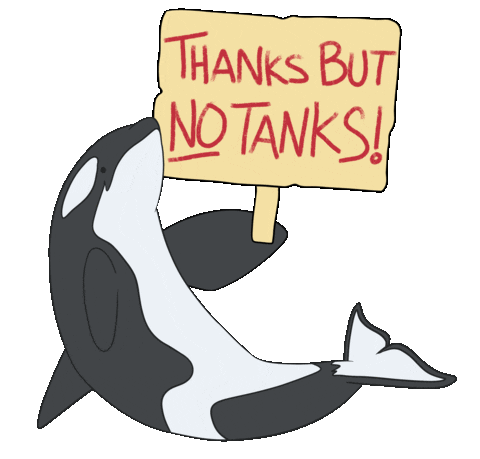
Orca say "Thanks, but no tanks!"
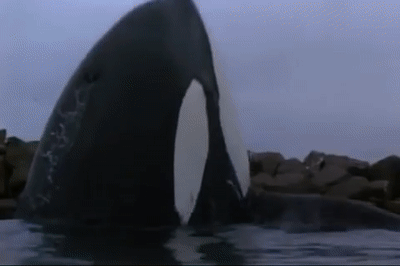
Famous scene from Free Willy (1993)
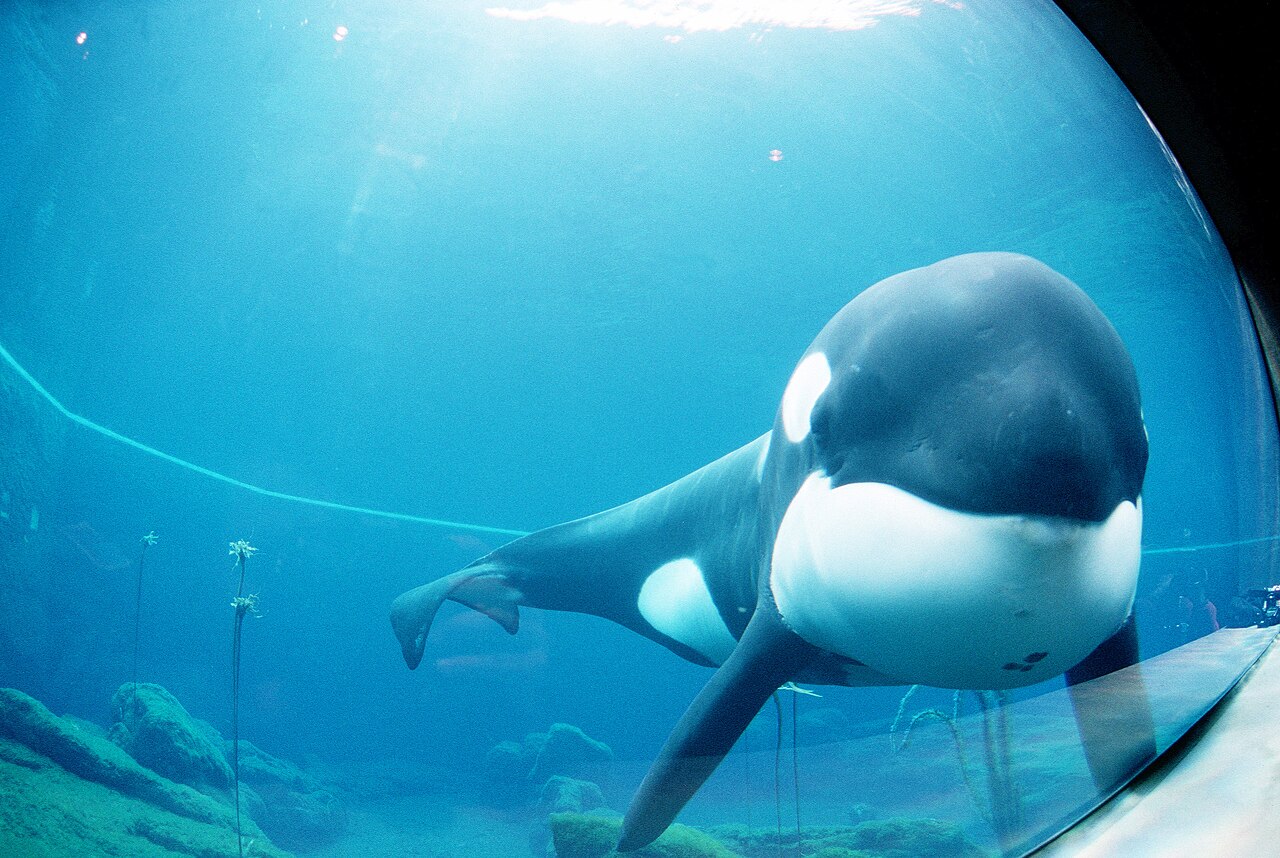
Keiko at Oregon Coast Aquarium

Likely most famously, orca are known for being kept and shown in captivity. SeaWorld, MarineLand, Moskvarium, and many other similar marine parks throughout the world keep orca in tanks and use them for performance shows. SeaWorld’s Shamu started their orca shows in 1965, with the name being passed on as a ‘stage name’ to many subsequent orca. From 1961 to 1972, orca in the Pacific were massively ‘hunted’ for captures, and 60-70 whales were taken to be kept on show at aquariums and marine parks. These captures particularly decimated the SRKW community, leading to their current low population and endangered status After 1972, many captures were conducted in Icelandic waters, including some of the most famous SeaWorld orca, Keiko and Tilikum.
As shown previously, orca are highly intelligent and highly social animals, with studies suggesting rich emotional experiences. Their home ranges are wide and varied, with different populations used to different climate, diets, and social lives. In captivity, this causes a range of problems. Tanks are completely unable to replicate the scale of habitat needed for orca, with many tanks being so undersized as to barely allow room for the whales to swim; Lolita lived most of her captive life in a tank only four times her own length, and Keiko spent years in a tank so small he could barely straighten himself out. Most tanks are also bare, with blank concrete walls offering no stimulation. These tanks can also interfere with orca’s sonar, reflecting calls back to them, with noise from the surrounding environment causing more distress.
In captivity, the usual social structures and bonds of orca are completely absent. Many orca in captivity were wild-caught – taken from a wild pod, and placed into captivity. This generally occurred when the whales were young, between 1 and 4 years old. Even in captive-born orca, young whales are often removed from their mothers and sent to other parks, which disrupts the vital mother-calf bond. Orca often do not wean until 2 years old, and especially within Resident communities, will never leave their mothers even into adulthood. This makes the early separation very distressing to both mothers and calves.
Sometimes in captivity orca from different populations are placed together in artificial ‘pods’ – since lifestyles and ‘language’ differ so greatly, this can often result in tension, conflict and hostility between individuals. Even without this factor, it is well documented that whale relations can often be fraught in captive environments, potentially exacerbated by lack of space to get away from each other. Fights, injuries and deaths have all been recorded in captivity, and at much higher rates than observed in the wild. Tilikum is known to have sustained many injuries from his first two tankmates, Haida II and Nootka IV, at Sealand of the Pacific, and in 1989 Kandu V died after injuries sustained while trying to charge and rake tankmate Corky II.
In the wild, orca often show communal care – with mother orca showing their daughters how to raise calves, and various members of the pod helping mothers with care. Without this access to culture and family, many abnormal behaviours are seen in captive orca. Females may not know how to feed their calves, or may play too roughly with them, or even attack them. Incest and inbreeding is also known to have occurred in captive whales, while it is rare in wild populations. On top of this, artificial breeding programmes have resulted in low genetic diversity in captive whales – Tilikum was the most widely bred whale, siring 21 calves (18 of which survived to adulthood) and with over 50% of captive SeaWorld whales descending from him. These artificial breeding programmes have also resulted in hybrid orcas, with Residents and Transients from across the world being bred together despite never doing so in the wild.
Since this issue was widely brought to attention by the 1993 film Free Willy and then the death of Dawn Brancheau in 2010 and subsequent documentary Blackfish, the topic of cetacean rights has been far more in the foreground of public consciousness. There have been some positive outcomes of this movement – for example, the laws passed in California to stop captive breeding of orca; minor improvements to some tanks, but still nothing ethical for orca; and rules that trainers no longer enter pools, and shows have changed. Hopefully, this signals the beginning of the end for cetacean captivity, at least in the US. Despite this, there are still major concerns – oceanariums have previously ‘rescued’ wild whales and then not re-released them. Morgan was a young whale found alone and sick in 2010; Dolfinarium Harderwijk took her in and cared for her under a rehabilitation and release permit - however she was then transferred to Loro Parque and has been kept there since. Wild captures still happen - most notably, in Russian waters. At least 15 orca have been captured from Russian shores and sold to Chinese oceanariums between 2013 and 2016.


Current opinion is that wild release is not an option, especially for captive-born orca. This is due to many factors. For one, a lot of captive-born orca are hybrids; Tilikum, SeaWorld’s most prolifically bred orca, was of Icelandic descent, while many of the females he was bred with were NRKW or SRKW. In the wild, these types of cross-breeds do not occur, as different populations and ecotypes of orca will show active avoidance of other ecotypes when their territories cross. Additionally, several orca populations never meet due to territory. This means that introducing hybrid individuals to the wild could have effects on wild populations, interfering with genetic evolution and diversity in currently existing populations.
There is also the problem of socialisation. Orca societies are complex, and different groups have very different vocalisations, hunting strategies, pod organisations, and behaviours. Captive-born orca have never had the proper socialisation necessary for integration. Most were separated from their mothers young and never learned appropriate social skills; since orcas are often kept in mixed ecotype groups, they may not know the correct behaviours and calls for any one group; they have only ever been hand-fed dead fish, and never hunted. Additionally, orca society is highly ordered based on matriline – in ecotypes where separation of daughters from their mothers in adulthood is the norm, there may be no pod to integrate into, especially for those orca whose mothers have died.
Even with wild-caught orca, wild-release may not be an option. As seen with the case of Keiko, some whales may not be able to reintegrate into wild populations. Again, due to the matrilineal structure of orca pods, without proper identification of a matriline pod, an orca may have no community to return to. It is possible that Keiko’s family was not identified, and therefore he had nowhere to go. Due to the young age that many orca were captured at they may also be missing key socialisation skills, and due to years in captivity, may not know how to hunt for themselves. They also are habituated to humans, and this can be dangerous for orca; they may approach boats and be injured by propellers, or spend too much time close to shore.
Despite all this, many people still believe captive orca should be removed from the unethical tank environments they are kept in. Currently, the most accepted alternative is to relocate orca to sea-pens. This might still have some problems – sea-pens are still far more restricted in terms of size than normal orca territories, and there is more possibility for injury or illness to occur – but is a quality of life improvement over tiny bare tanks. However, such relocations are expensive and so far no marine park has been willing to give up their orca, nor help pay for their relocation. Various charities and wildlife organisations have attempted to set up sanctuaries and funds, but this is a fight that is still ongoing.

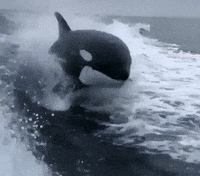
An orca riding in the wake of a boat
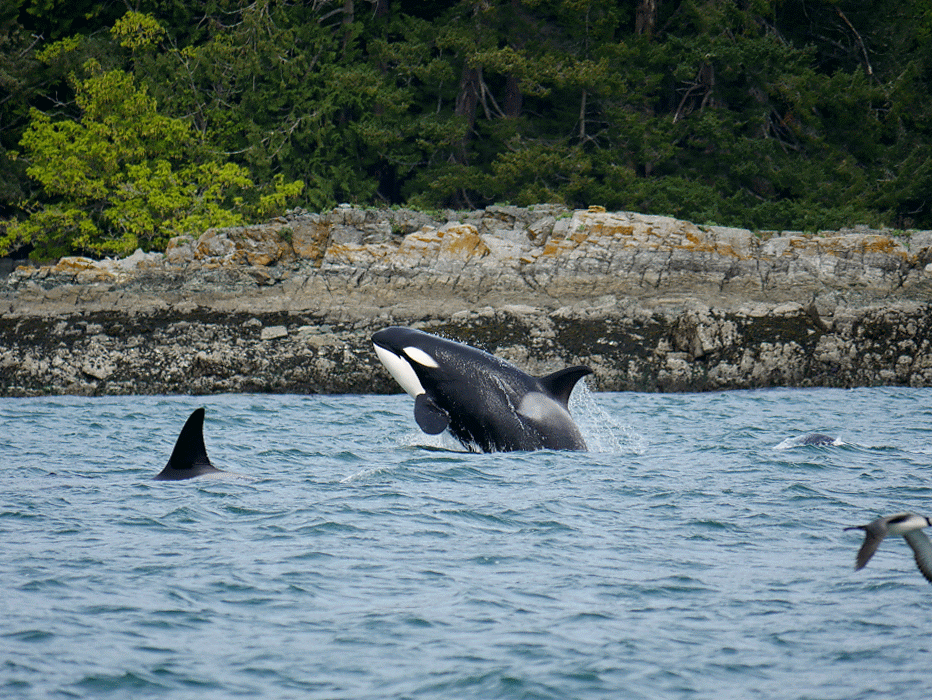
An orca breaches off the shores of Vancouver
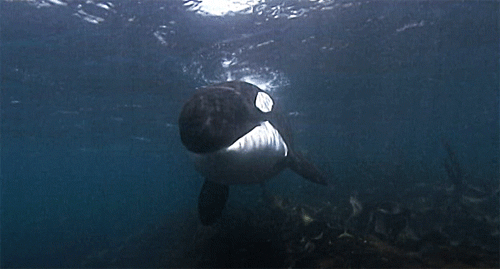
An orca investigates a camera
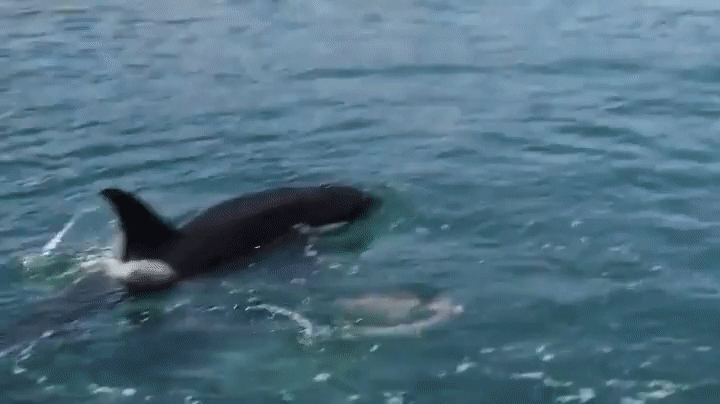
An orca attacks a shark by lobtailing.
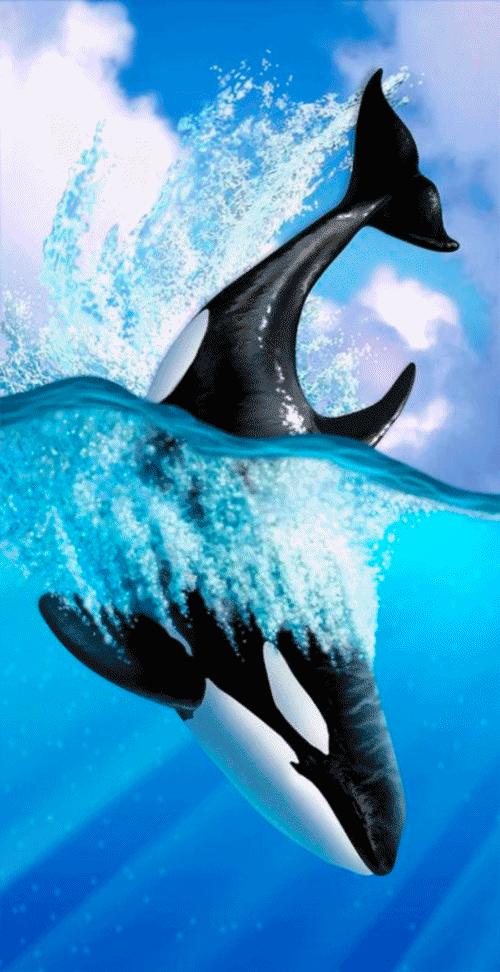
Animation of an orca diving

After all of this, we come to my personal opinion of this. I love orca – or, you know, I wouldn’t have made a huge web-shrine for them – and I think they are beautiful and fascinating creatures. As a child I was always an animals and nature guy, and orca were always up there as one of my top favourites (alongside cheetahs). Free Willy was a foundational film in my childhood, and definitely helped kickstart my love for these animals. I do also believe they are highly intelligently and highly emotional in a way that is comparative to humans. I would love to see more research done into orca culture and community, and better education on their lives and ecology.
From my own research, I believe in cetacean rights (the proposal that cetaceans be granted legal rights and legal personhood to protect them), and think their captivity is cruel and deeply unethical. While I am a support of zoos and aquariums as conservation and education tools, I think that there is a duty for adequate, ethical care to be provided to any animals kept in such facilities, and I do not believe that is possible in captivity. I live in the UK, where cetacean captivity is not specifically banned, but animal rights laws make it impossible to keep them, as no captive environment can properly meet their needs. All evidence points to captivity being damaging and cruel to them, and for very little benefit to us or them.
I think many ‘problem’ whales, such as Tilikum, have shown signs of what could be called depression, anxiety, and psychosis; this, unsurprisingly, has led them to harm themselves, each other, and humans. Due to the intelligence and emotional complexity observed in these animals, I do not think it’s a far stretch to suggest that they may suffer mentally in the same or similar ways to humans; and, to me, this fits with the behaviours that have been observed. I also think the fact that half a dozen deaths can be attributed to captive orca, but next to no attacks and exactly 0 fatalities have been recorded from wild orca, shows that captivity is the problem in this equation.
While I agree wild release should not be an option for captive bred orca, I do wonder if it may be possible for some of the wild-caught orca still alive. Unfortunately, many of the orca I was aware had possible release potential – such as Lolita/Tokitae – have sadly died in captivity. Morgan could, I believe, be a good candidate for release, as she has been shown to still remember and respond to her pod’s calls – however, this is very unlikely to happen. In any case, I think sea-pens and ocean sanctuaries may be the kindest outcome to phase out orca captivity for good. I believe this extends to other cetaceans, such as belugas, bottlenoses, and pilot whales, which are also often kept in captivity. Although orca are my favourites, I know that a lot of what has been said about them and their intelligence applies more widely to other cetaceans.
Personally, I think you should love them too! They are very charismatic, and there is a wealth of information on them. Learning more about orca is fascinating, and there are several teams dedicated to whale spotting, making records, and investigating various populations. If you do choose to [DIVE IN], I encourage you to do your own reading and come to your own conclusions – and hey, do come and talk with me about these awesome animals!!
